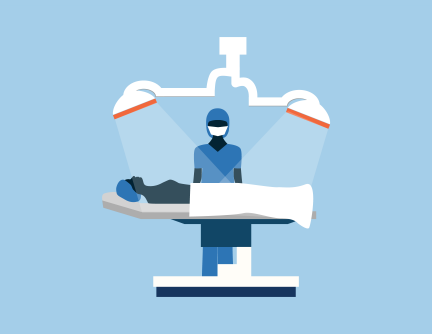

Choosing the best treatment for low-risk DCIS is often very difficult. You may receive complex and conflicting information from medical experts. It is normal to feel uncertain or anxious when considering options, but it is important to be informed about the potential benefits and risks of treatments.
The treatment for DCIS is not "one-size fits all." You should take your time and obtain as much specific information about your particular kind of DCIS as possible. This information is found on your pathology report. It is also important to understand the pros and cons of each treatment option and consider the potential short and long-term benefits and risks of each treatment. In addition to your doctor, a support team is important to help you gather and understand information about the different kinds of DCIS and potential clinical trials. You may want a second opinion from various specialists such as a pathologist, an oncologist or a breast surgeon.
The different types of surgeries are described below. There may be physical, emotional and psychological side effects with any of these procedures, including bruising, bleeding, pain, and changes to the look and feel of your breasts. Side effects and financial costs may have an impact on your daily life.

If you choose a surgery, you reduce your risk of future breast cancer or future DCIS; however, a study suggests there may be no long-term survival benefit for women with low-grade DCIS who have surgery compared to women who did not have surgery. The phrase 'no survival benefit' means that the long-term survival of women who had surgery was not different than the women who did not have surgery. The reasons for this are not fully understood, but women may be dying of other causes. More study is needed to fully understand the benefits and risks of surgical treatment for low-grade DCIS.
Mastectomy
A mastectomy is surgery which usually removes all breast tissue. It may be recommended if radiation therapy is not possible, for example, in pregnant women or women who have had previous radiation. Mastectomy may be suggested if there are several areas of DCIS in the breast. It may also be suggested if there is a lot of DCIS within the breast. No radiation is needed since the entire breast is removed.
Lumpectomy
A lumpectomy is also known as "breast-conserving surgery." It removes only the area of breast tissue with the DCIS that is seen on imaging (such as a mammogram or MRI). A small amount of healthy, normal tissue around the DCIS will also be removed to make sure that the area with DCIS is clear of any abnormal cells. This is called a clear margin.
Breast Reconstruction
If a mastectomy is chosen, you may want to consult with a plastic surgeon to see if breast reconstruction can also be performed. This can either be at the same time or at a later date. Breast reconstruction is a type of plastic surgery that rebuilds the breast. Either breast implants or your own tissue may be used for breast reconstruction. These options should be discussed with a plastic surgeon, but breast reconstruction cannot replace the normal look and feel of the breast.
Radiation therapy may be offered to women following surgery. However, it may not be necessary for women with low-risk DCIS. Whether or not to have radiation therapy can often be a hard decision. It may provide peace of mind by lowering the likelihood of a future DCIS or invasive breast cancer, but there is no survival benefit associated with radiation therapy for low-risk DCIS. This means that the survival of women who have radiation is not different than for women who do not have radiation.

It is important to note that radiation therapy can only be done once to a particular area of the body, which is a consideration in case invasive breast cancer develops in the future. Radiation side effects include fatigue, a temporary sunburn like effect on the skin and changes in the texture of the breast. Long-term effects of radiation therapy are not as well studied, but include an increased risk of cancer and damage to the heart, lungs, thyroid and bones; it also increases the probability of lymphedema.
The best way to manage low-risk DCIS is still unknown. Active monitoring is a relatively new management strategy for breast cancer that is adopted from the prostate cancer field, where it has a long track record. Like low-risk DCIS of the breast, some prostate cancers are not invasive and do not grow.
The aim of active monitoring is to monitor the DCIS closely. You have a mammogram and a check-up with a clinician every six months. If no changes in the breast are seen, you stay on active monitoring and avoid surgery and its side-effects. If any changes in the breast are seen on a mammogram, they are explained to you at your visit. The doctor may recommend that you continue with active monitoring or have more tests, such as a biopsy, to investigate the changes. When you have the test results, you may be able to continue with active monitoring, or the results may indicate that you should undergo surgery.
Some women on active monitoring may feel anxious knowing that the DCIS has not been removed. You will have mammography and screening every six months. For some women this may become stressful. Active monitoring will need to be continued for many years. These side effects and financial costs may affect your daily life.
Currently, active monitoring is not widely available. That is because there is not yet enough evidence. Active monitoring is being studied as part of a clinical trial called the COMET (Comparing an Operation to Monitoring, with or without Endocrine Therapy, for low-risk DCIS) Study. Learn more about the COMET study here.
Endocrine therapy is not the same as chemotherapy or hormone replacement therapy. Endocrine therapy is a pill that is used in DCIS treatment by blocking hormones. This medication may lower your risk of developing a future DCIS or invasive breast cancer. However, benefits gained from endocrine therapy should be weighed against potential side effects. These may include hot flashes, joint pain, weight gain, bone changes, blood clots, and cancers. Different types of endocrine (hormone-blocking) therapy may be considered based on the person's age and menopausal status and are described below.

Tamoxifen
Tamoxifen is offered to both women who still have monthly periods (premenopausal) or to women who have finished their monthly periods (postmenopausal). Tamoxifen works by blocking hormones to prevent the growth of cancer cells.
Aromatase inhibitors
Post-menopausal women may be given medicines called aromatase inhibitors. These medicines lower the amount of female hormones in the body. They are usually taken in pill form once a day. There are several different aromatase inhibitors that are similarly effective.
For more information on treatment options, see also: